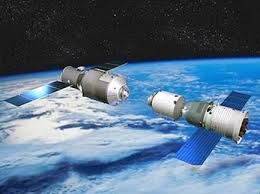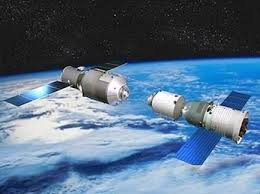
The Tiangong-1, or “Heavenly Palace”, China’s first prototype space station, reached the end of its service life earlier this year after having being launched into orbit in September 2011. In a recent press conference, the Chinese space agency admitted that it had lost contact with the station but did not explain what had gone wrong, even as the space station was due to splashdown in the Pacific Ocean.
But does losing contact with the space station matter?
This however depends on the next plan of the Chinese. The loss of contact means little if the Chinese intend to let the space station burn up in the atmosphere while it is allowed to simply fall to Earth in an uncontrolled manner. However the option of performing a controlled ‘de-orbit’ is now gone with loss of communications. For spacecraft that pose a potential risk to people when they fall back to Earth, the controlled de-orbit exercise if undertaken.
The spacecraft should be actively steered into a region of the South Pacific known in the business as the “spacecraft graveyard” if the chances of someone getting injured by components that survive the fireball of re-entry is greater than one in 10,000. However there is no risk of a collision on its way down as the module is already below the altitude of the International Space Station (ISS).
Tiangong-1 is a mere 10 metres long and 3 metres wide and small compared to the massive ISS, which is the size of a football field and has the living space of a five-bedroom house. Including two women, spent time aboard after catching a ride on the Shenzhou spacecraft, the Chinese used the module to practice rendezvous and docking procedures, and several taikonauts. More than a blow to their space program, losing control of the module is more of an embarrassment to the Chinese space agency. With a crew of at least two taikonauts is expected to visit as early as next month, the Chinese put another space station module, Tiangong-2, into orbit two weeks ago in a long-scheduled launch. The agency still hopes to build a 55-tonne space station by 2020.
Travelling at 27,500km per hour, the Chinese module at 380km high, shows satellite tracking radars. Before it starts to feel the drag of the upper atmosphere and begin its final descent, it could lap the planet 5,000 more times at that speed and altitude. While the Chinese space agency has conceded that some heat-resistant components may survive, most of the 8.5-tonne module is expected to burn up from aerodynamic heating in the Earth’s atmosphere.
“The module is predominantly a hollow shell, so there’s a good chance a significant portion will burn up in the atmosphere. But there’s also a chance some elements will survive down to surface,” said Hugh Lewis, a space debris expert at University of Southampton.
But no one knows where it would come down on Earth. And even in its final moments, it will be impossible to predict that with accuracy given the vagaries of re-entry. Which orbit a spacecraft will re-enter is not possible to be known form computer simulations far in advance.
Nasa’s 85-tonne Skylab space station came down over Australia in 1979 and it was the most dangerous uncontrolled re-entry. Roscosmos de-orbited the 135-tonne outpost into the Pacific in 2001 when the Russian Mir space station had reached the end of its life. But no one is known to have been hurt by falling space junk even with so much hardware raining from the skies.
“It is luck, but it proves that luck is on our side,” said Lewis.
Since most of the world’s population is crammed into a small percentage of land and most of the Earth’s surface is covered with water, the odds are wildly in favor of not being hit. In this aspect death by lightning is far more likely as the chances of a specific individual being struck by falling debris is trillions to one.
(Source:www.theguardian.com)
But does losing contact with the space station matter?
This however depends on the next plan of the Chinese. The loss of contact means little if the Chinese intend to let the space station burn up in the atmosphere while it is allowed to simply fall to Earth in an uncontrolled manner. However the option of performing a controlled ‘de-orbit’ is now gone with loss of communications. For spacecraft that pose a potential risk to people when they fall back to Earth, the controlled de-orbit exercise if undertaken.
The spacecraft should be actively steered into a region of the South Pacific known in the business as the “spacecraft graveyard” if the chances of someone getting injured by components that survive the fireball of re-entry is greater than one in 10,000. However there is no risk of a collision on its way down as the module is already below the altitude of the International Space Station (ISS).
Tiangong-1 is a mere 10 metres long and 3 metres wide and small compared to the massive ISS, which is the size of a football field and has the living space of a five-bedroom house. Including two women, spent time aboard after catching a ride on the Shenzhou spacecraft, the Chinese used the module to practice rendezvous and docking procedures, and several taikonauts. More than a blow to their space program, losing control of the module is more of an embarrassment to the Chinese space agency. With a crew of at least two taikonauts is expected to visit as early as next month, the Chinese put another space station module, Tiangong-2, into orbit two weeks ago in a long-scheduled launch. The agency still hopes to build a 55-tonne space station by 2020.
Travelling at 27,500km per hour, the Chinese module at 380km high, shows satellite tracking radars. Before it starts to feel the drag of the upper atmosphere and begin its final descent, it could lap the planet 5,000 more times at that speed and altitude. While the Chinese space agency has conceded that some heat-resistant components may survive, most of the 8.5-tonne module is expected to burn up from aerodynamic heating in the Earth’s atmosphere.
“The module is predominantly a hollow shell, so there’s a good chance a significant portion will burn up in the atmosphere. But there’s also a chance some elements will survive down to surface,” said Hugh Lewis, a space debris expert at University of Southampton.
But no one knows where it would come down on Earth. And even in its final moments, it will be impossible to predict that with accuracy given the vagaries of re-entry. Which orbit a spacecraft will re-enter is not possible to be known form computer simulations far in advance.
Nasa’s 85-tonne Skylab space station came down over Australia in 1979 and it was the most dangerous uncontrolled re-entry. Roscosmos de-orbited the 135-tonne outpost into the Pacific in 2001 when the Russian Mir space station had reached the end of its life. But no one is known to have been hurt by falling space junk even with so much hardware raining from the skies.
“It is luck, but it proves that luck is on our side,” said Lewis.
Since most of the world’s population is crammed into a small percentage of land and most of the Earth’s surface is covered with water, the odds are wildly in favor of not being hit. In this aspect death by lightning is far more likely as the chances of a specific individual being struck by falling debris is trillions to one.
(Source:www.theguardian.com)














